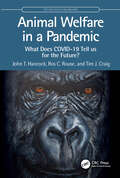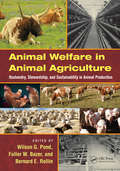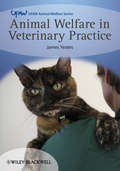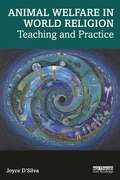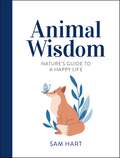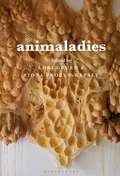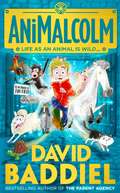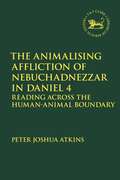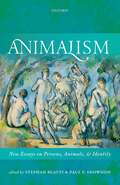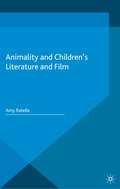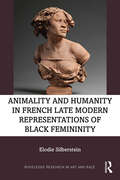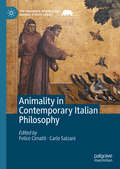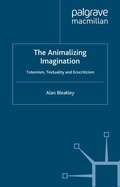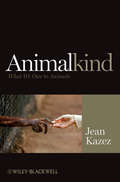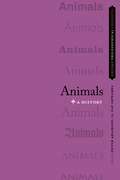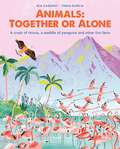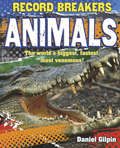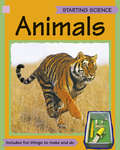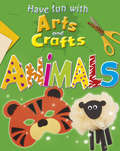- Table View
- List View
Animal Welfare in a Pandemic: What Does COVID-19 Tell us for the Future? (CRC One Health One Welfare)
by John T. Hancock Ros C. Rouse Tim J. CraigAnimal Welfare in a Pandemic explores the impact of COVID-19 on a wide array of animals, from those in the wild to companion and captive animals. During the height of the pandemic, a range of animals were infected, and many died, but this was hard to predict, even using up-to-date bioinformatics. Lockdowns around the world had, and continue to have, a major effect on animals’ welfare, influencing pet ownership and care, as well as impacting on the work of conservation institutes due to the lack of visitors and funding and lack of tourist presence in the wild which impacted on anti-poaching efforts. Some of the vast amount of personal protection equipment (PPE) that was distributed was discarded, creating both dangers and occasional opportunities for wild animals. With the rollout of human vaccines, some countries started developing animal vaccines, only some of which were deployed. In summary, the pandemic had a wide-ranging influence on animal welfare around the world. This is reviewed to highlight what can be learned to protect and enhance animal welfare in future epidemics/pandemics, and contribute to a genuinely One Health approach where the health and welfare of both humans and animals are considered holistically.This book is authored by members of the University of the West of England, Bristol, who span a range of expertise in Biological Sciences, Social Sciences, Animal Welfare, and Ethics.
Animal Welfare in Animal Agriculture: Husbandry, Stewardship, and Sustainability in Animal Production
by Wilson G. Pond Fuller W. Bazer Bernard E. RollinWhat constitutes animal welfare? With animals being used for companionship, service, research, food, fiber, and by-products, animal welfare is a topic of great interest and importance to society. As the world's population continues to increase, a major challenge for society is the maintenance of a strong and viable food system, which is linked to t
Animal Welfare in Veterinary Practice (UFAW Animal Welfare)
by James YeatesA practical guide to help veterinarians improve the welfare of their patients in their everyday work. A concise and accessible introduction to welfare that is both interesting and valuable in practice. The book describes ways to evaluate patients, develop in-practice quality of life assessments, resolve difficult clinical dilemmas, and turn good decisions into real welfare outcomes. It reviews available scientific information, legal issues and ethical dilemmas, and relates these to everyday case studies throughout. It provides ways for all veterinary professionals to develop their animal welfare understanding, without assuming prior knowledge, while advancing the wisdom and abilities of experienced practitioners. Key features: Presents practical and realistic methods for working with owners to improve patients' welfare within the constraints of everyday practice. Provides useful advice for work within many legal jurisdictions. Includes summaries of research, vital references, and further reading sources. Key points are recapped at the end of each chapter. Suitable for all those working in the veterinary and related professions, including veterinarians, veterinary nurses, animal welfare scientists, animal behaviourists, paraprofessionals and lay staff. Published as a part of the prestigious Wiley-Blackwell – UFAW Animal Welfare series. UFAW, founded 1926, is an internationally recognised, independent, scientific and educational animal welfare charity. For full details of all titles available in the UFAW series, please visit www.wiley.com/go/ufaw.
Animal Welfare in Veterinary Practice (UFAW Animal Welfare)
by James YeatesA practical guide to help veterinarians improve the welfare of their patients in their everyday work. A concise and accessible introduction to welfare that is both interesting and valuable in practice. The book describes ways to evaluate patients, develop in-practice quality of life assessments, resolve difficult clinical dilemmas, and turn good decisions into real welfare outcomes. It reviews available scientific information, legal issues and ethical dilemmas, and relates these to everyday case studies throughout. It provides ways for all veterinary professionals to develop their animal welfare understanding, without assuming prior knowledge, while advancing the wisdom and abilities of experienced practitioners. Key features: Presents practical and realistic methods for working with owners to improve patients' welfare within the constraints of everyday practice. Provides useful advice for work within many legal jurisdictions. Includes summaries of research, vital references, and further reading sources. Key points are recapped at the end of each chapter. Suitable for all those working in the veterinary and related professions, including veterinarians, veterinary nurses, animal welfare scientists, animal behaviourists, paraprofessionals and lay staff. Published as a part of the prestigious Wiley-Blackwell – UFAW Animal Welfare series. UFAW, founded 1926, is an internationally recognised, independent, scientific and educational animal welfare charity. For full details of all titles available in the UFAW series, please visit www.wiley.com/go/ufaw.
Animal Welfare in World Religion: Teaching and Practice
by Joyce D'SilvaThis unique and readable book examines the relationship between religion and animal welfare, taking a detailed dive into the teachings and practices of the major world religions. While there are many books expounding the beliefs of the major religions and many about the rights and welfare of animals, there are few linking the two. With each chapter focusing on one of the five major religions – Judaism, Christianity, Islam, Hinduism and Buddhism – the book explores the beliefs and practices which drive our relationship with and treatment of animals. The book draws on the scriptures of the major faiths and includes the voices of leading historical religious figures and contemporary faith leaders. In doing so, it compares the teachings of old with contemporary practices and showcases the impact of the major religions on both the protection and exploitation of animals, from running animal sanctuaries, to participating in or condoning cruel sports and factory farming. Importantly, the book also includes a chapter looking beyond the major world religions, where it examines a wider range of beliefs and practices, including Indigenous peoples from the USA and Australia, Jainism, Sikhism and Rastafarianism, to provide fascinating insights into another range of beliefs and views on the human-animal relationship. Overall, this book challenges and encourages religious leaders and followers to re-examine their teachings and to prioritise the well-being of animals. This book is essential reading for those interested in the role of religion in animal welfare, human-animal studies, and animal welfare and ethics more broadly.
Animal Welfare in World Religion: Teaching and Practice
by Joyce D'SilvaThis unique and readable book examines the relationship between religion and animal welfare, taking a detailed dive into the teachings and practices of the major world religions. While there are many books expounding the beliefs of the major religions and many about the rights and welfare of animals, there are few linking the two. With each chapter focusing on one of the five major religions – Judaism, Christianity, Islam, Hinduism and Buddhism – the book explores the beliefs and practices which drive our relationship with and treatment of animals. The book draws on the scriptures of the major faiths and includes the voices of leading historical religious figures and contemporary faith leaders. In doing so, it compares the teachings of old with contemporary practices and showcases the impact of the major religions on both the protection and exploitation of animals, from running animal sanctuaries, to participating in or condoning cruel sports and factory farming. Importantly, the book also includes a chapter looking beyond the major world religions, where it examines a wider range of beliefs and practices, including Indigenous peoples from the USA and Australia, Jainism, Sikhism and Rastafarianism, to provide fascinating insights into another range of beliefs and views on the human-animal relationship. Overall, this book challenges and encourages religious leaders and followers to re-examine their teachings and to prioritise the well-being of animals. This book is essential reading for those interested in the role of religion in animal welfare, human-animal studies, and animal welfare and ethics more broadly.
Animal Wisdom: Nature's Guide to a Happy Life
by Sam HartSelf-care gone wild Slow down like a sloth, stretch like a cat, breathe deep like a whale and have the confidence of a lion. When life gets you down, lift your spirits with these tiny tips and helpful hints from our friends in the animal kingdom.
Animaladies: Gender, Animals, and Madness
by Carol J. Adams Professor Lori Gruen Professor Fiona Probyn-RapseyDo depictions of crazy cat ladies obscure more sinister structural violence against animals hoarded in factory farms?Highlighting the frequent pathologization of animal lovers and animal rights activists, this book examines how the "madness†? of our relationships with animals intersects with the "madness†? of taking animals seriously. The essays collected in this volume argue that "animaladies†? are expressive of political and psychological discontent, and the characterization of animal advocacy as mad or "crazy†? distracts attention from broader social unease regarding human exploitation of animal life.While allusions to madness are both subtle and overt, they are also very often gendered, thought to be overly sentimental with an added sense that emotions are being directed at the wrong species. Animaladies are obstacles for the political uptake of interest in animal issues-as the intersections between this volume and established feminist scholarship show, the fear of being labeled unreasonable or mad still has political currency.
Animaladies: Gender, Animals, and Madness
by Lori Gruen Carol J. Adams Fiona Probyn-RapseyDo depictions of crazy cat ladies obscure more sinister structural violence against animals hoarded in factory farms?Highlighting the frequent pathologization of animal lovers and animal rights activists, this book examines how the “madness” of our relationships with animals intersects with the “madness” of taking animals seriously. The essays collected in this volume argue that “animaladies” are expressive of political and psychological discontent, and the characterization of animal advocacy as mad or “crazy” distracts attention from broader social unease regarding human exploitation of animal life.While allusions to madness are both subtle and overt, they are also very often gendered, thought to be overly sentimental with an added sense that emotions are being directed at the wrong species. Animaladies are obstacles for the political uptake of interest in animal issues-as the intersections between this volume and established feminist scholarship show, the fear of being labeled unreasonable or mad still has political currency.
AniMalcolm
by David Baddiel Jim FieldFrom David Baddiel, the brightest new star of children's books and winner of the LOLLIES award, comes a laugh-out-loud adventure for every child who ever wondered what it might be like to be a bit of an animal. . . Malcolm doesn't like animals. Which is a problem because his family love them. Their house is full of pets. What the house is NOT full of is stuff Malcolm likes. Such as the laptop he wanted for his birthday. The only bright spot on the horizon is the Year Six school trip, which Malcolm never thought his parents would pay for. And yet there he is, on the bus, heading to. . . oh no. A farm. Over the next days, Malcolm changes. He learns a lot about animals. More, in many ways, than he would like. He learns what it's really like to be an animal. A whole series of animals, in fact. . . It does make him think differently. And speak differently. And eat differently. And, um, smell differently. But will he end up the same as before? Because sometimes the hardest thing to become is. . . yourself.
AniMalcolm (PDF)
by David Baddiel Jim FieldFrom David Baddiel, the brightest new star of children's books and winner of the LOLLIES award, comes a laugh-out-loud adventure for every child who ever wondered what it might be like to be a bit of an animal. . . Malcolm doesn't like animals. Which is a problem because his family love them. Their house is full of pets. What the house is NOT full of is stuff Malcolm likes. Such as the laptop he wanted for his birthday. The only bright spot on the horizon is the Year Six school trip, which Malcolm never thought his parents would pay for. And yet there he is, on the bus, heading to. . . oh no. A farm. Over the next days, Malcolm changes. He learns a lot about animals. More, in many ways, than he would like. He learns what it's really like to be an animal. A whole series of animals, in fact. . . It does make him think differently. And speak differently. And eat differently. And, um, smell differently. But will he end up the same as before? Because sometimes the hardest thing to become is. . . yourself.
Animalising Affliction of Nebuchadnezzar in Daniel 4: Reading Across the Human-Animal Boundary (The Library of Hebrew Bible/Old Testament Studies)
by Peter Joshua AtkinsThis is a detailed investigation into the nature of Nebuchadnezzar's animalising affliction in Daniel 4 and the degree to which he is depicted as actually becoming an animal. PeterAtkins examines two predominant lines of interpretation: either Nebuchadnezzar undergoes a physical metamorphosis of some kind into an animal form; or diverse other readings that specifically preclude or deny an animal transformation of the king. By providing an extensive study of these interpretative opinions, alongside innovative assessments of ancient Mesopotamian divine-human-animal boundaries, Atkins ultimately demonstrates how neither of these traditional interpretations best reflect the narrative events. While there have been numerous metamorphic interpretations of Daniel 4, these are largely reliant upon later developments within the textual tradition and are not present in the earliest edition of Nebuchadnezzar's animalising affliction. Atkins' study displays that when Daniel 4 is read in the context of Mesopotamian texts, which appear to conceive of the human-animal boundary as being indicated primarily in relation to possession or lack of the divine characteristic of wisdom, the affliction represents a far more significant categorical change from human to animal than has hitherto been identified.
Animalism: New Essays on Persons, Animals, and Identity
What are we? What is the nature of the human person? Animalism has a straightforward answer to these long-standing philosophical questions: we are animals. After being ignored for a long time in philosophical discussions of our nature, this idea has recently gained considerable support in metaphysics and philosophy of mind. It has also, amongst philosophers, occasioned strong opposition, even though it might be said to be the view assumed by much of the scientific community. Essays on Animalism is the first volume to be devoted to this important topic and promises to set the agenda for the next stage in the debate. Containing mainly new papers as well as two highly important articles that were recently published elsewhere, this volume's contributors include both emerging voices in the debate and many of those who have been instrumental in shaping it. Some of their contributions defend animalism, others criticize it, still others explore its more general implications. The book also contains a substantial introduction by the editors explaining what animalism is, identifying leading issues that merit attention, and highlighting many of the issues that the contributors have raised.
Animality and Children's Literature and Film (Critical Approaches to Children's Literature)
by A. RatelleExamining culturally significant works of children's culture through a posthumanist, or animality studies lens, Animality and Children's Literature and Film argues that Western philosophy's objective to establish a notion of an exclusively human subjectivity is continually countered in the very texts that ostensibly work to this end.
Animality and Humanity in French Late Modern Representations of Black Femininity (Routledge Research in Art and Race)
by Elodie SilbersteinThis volume examines the evolution of the depictions of black femininity in French visual culture as a prism through which to understand the Global North’s destructive relationship with the natural world. Drawing on a broad spectrum of archives extending back to the late 18th century – paintings, fashion plates, prints, photographs, and films – this study traces the intricate ways a patriarchal imperialism and a global capitalism have paired black women with the realm of nature to justify the exploitation both of people and of ecosystems. These dehumanizing and speciesist strategies of subjugation have perpetuated interlocking patterns of social injustice and environmental depletion that constitute the most salient challenges facing humankind today. Through a novel approach that merges visual studies, critical race theory, and animal studies, this interdisciplinary investigation historicizes the evolution of the boundaries between human and non-human animals during the modern period. The book will be of interest to scholars working in art history, visual studies, critical race theory, colonial and post-colonial studies, animal studies, and French studies.
Animality and Humanity in French Late Modern Representations of Black Femininity (Routledge Research in Art and Race)
by Elodie SilbersteinThis volume examines the evolution of the depictions of black femininity in French visual culture as a prism through which to understand the Global North’s destructive relationship with the natural world. Drawing on a broad spectrum of archives extending back to the late 18th century – paintings, fashion plates, prints, photographs, and films – this study traces the intricate ways a patriarchal imperialism and a global capitalism have paired black women with the realm of nature to justify the exploitation both of people and of ecosystems. These dehumanizing and speciesist strategies of subjugation have perpetuated interlocking patterns of social injustice and environmental depletion that constitute the most salient challenges facing humankind today. Through a novel approach that merges visual studies, critical race theory, and animal studies, this interdisciplinary investigation historicizes the evolution of the boundaries between human and non-human animals during the modern period. The book will be of interest to scholars working in art history, visual studies, critical race theory, colonial and post-colonial studies, animal studies, and French studies.
Animality in Contemporary Italian Philosophy (The Palgrave Macmillan Animal Ethics Series)
by Carlo Salzani Felice CimattiThis volume provides an overview of contemporary Italian philosophy from the perspective of animality. Its rationale rests on two main premises: the great topicality of both Italian contemporary philosophy (the so-called “Italian Theory”) and of the animal question (the so-called “animal turn” in the humanities and the social sciences) in the contemporary philosophical panorama. The volume not only intersects these two axes, illuminating Italian Theory through the animal question, but also proposes an original thesis: that the animal question is a central and founding issue of contemporary Italian philosophy. It combines historical-descriptive chapters with analyses of the theme in several philosophical branches, such as biopolitics, Posthumanism, Marxism, Feminism, Antispeciesism and Theology, and with original contributions by renowned authors of contemporary Italian (animal) philosophy. The volume is both historical-descriptive and speculative and is intended for a broad academic audience, embracing both Italian studies and Animal studies at all levels.
The Animalizing Imagination: Totemism, Textuality and Ecocriticism
by A. BleakleyAnimals appear not just as biological creatures, but as vehicles of meaning for human imagination, mind and culture. Animal life may form the basis for an animalizing imagination that can enhance our cultural, religious and aesthetic sensibilities. This imagination is rooted in the pre-modern affective relationship between shamans and their familiars, but can be tracked to our post-modern ecological crisis, where we can reclaim a totemic identification with animals as signifiers of a new ecological understanding.
Animalkind: What We Owe to Animals (Blackwell Public Philosophy Series)
by Jean KazezBy exploring the ethical differences between humans and animals, Animalkind establishes a middle ground between egalitarianism and outright dismissal of animal rights. A thought-provoking foray into our complex and contradictory relationship with animals Advocates that we owe each animal due respect Offers readers a sensible alternative to extremism by speaking of respect and compassion for animals, not rights Balances philosophical analysis with intriguing facts and engaging tales
Animals: A History (Oxford Philosophical Concepts)
by Peter Adamson G. Fay EdwardsPhilosophical controversy over non-human animals extends further back than many realize -- before Utilitarianism and Darwinism to the very genesis of philosophy. This volume examines the richness and complexity of that long history. Twelve essays trace the significance of animals from Greek and Indian antiquity through the Islamic and Latin medieval traditions, to Renaissance and early modern thought, ending with contemporary notions about animals. Two main questions emerge throughout the volume: what capacities can be ascribed to animals, and how should we treat them? Notoriously ungenerous attitudes towards animals' mental lives and ethics status, found for instance in Aristotle and Descartes, are shown to have been more nuanced than often supposed, while remarkable defenses of benevolence towards animals are unearthed in late antiquity, India, the Islamic world, and Kant. Other chapters examine cannibalism and vegetarianism in Renaissance thought, and the scientific testing of animals. A series of interdisciplinary reflections sheds further light on human attitudes towards animals, looking at their depiction in visual artworks from China, Africa, and Europe, as well as the rich tradition of animal fables beginning with Aesop.
Animals: A crash of rhinos, a waddle of penguins and other fun facts
by Mia CassanySome animals need to live in big groups, although others barely interact with the rest of the herd. Do you want to know why?This book is full of colourful illustrations answering the questions of how, why and when animals decide to live in groups or alone. This useful and entertaining resource helps you discover fun facts about Flamingos, Polar Bears, Zebras, Emperor penguins and many more!
Animals: Animals Library Ebook (Record Busters #1)
by Daniel GilpinPerfect for capturing a young general reader's or an older reluctant reader's interest, these hi-lo titles feature gripping, minimal, fact-based text, dramatic and impactful pictures, and an edgy design to reveal the fastest, tallest, smallest, oldest or quirkiest!
Animals: Animal Homes (Project Science)
by Sally HewittFun, lively introductions to science with practical activities and projects to strengthen learning.
Animals (Have Fun with Arts and Crafts #5)
by Rita StoreyFun and engaging arts and crafts ideas centring on children's interests.
Animals: A History (Oxford Philosophical Concepts)
Philosophical controversy over non-human animals extends further back than many realize -- before Utilitarianism and Darwinism to the very genesis of philosophy. This volume examines the richness and complexity of that long history. Twelve essays trace the significance of animals from Greek and Indian antiquity through the Islamic and Latin medieval traditions, to Renaissance and early modern thought, ending with contemporary notions about animals. Two main questions emerge throughout the volume: what capacities can be ascribed to animals, and how should we treat them? Notoriously ungenerous attitudes towards animals' mental lives and ethics status, found for instance in Aristotle and Descartes, are shown to have been more nuanced than often supposed, while remarkable defenses of benevolence towards animals are unearthed in late antiquity, India, the Islamic world, and Kant. Other chapters examine cannibalism and vegetarianism in Renaissance thought, and the scientific testing of animals. A series of interdisciplinary reflections sheds further light on human attitudes towards animals, looking at their depiction in visual artworks from China, Africa, and Europe, as well as the rich tradition of animal fables beginning with Aesop.
